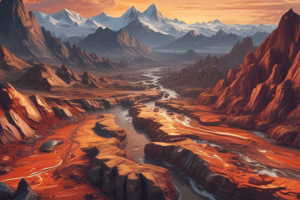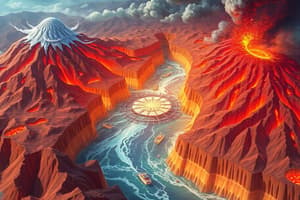Podcast
Questions and Answers
What is the primary driving force behind the movement of tectonic plates?
What is the primary driving force behind the movement of tectonic plates?
- Earth's magnetic field
- Gravitational forces
- Mantle convection currents (correct)
- Surface erosion
What occurs at divergent plate boundaries?
What occurs at divergent plate boundaries?
- Plates collide, creating mountains
- Plates move apart, leading to new crust formation (correct)
- Plates subduct, resulting in deep ocean trenches
- Plates slide past each other, causing earthquakes
Which force is responsible for the sinking of denser oceanic plates at subduction zones?
Which force is responsible for the sinking of denser oceanic plates at subduction zones?
- Slab pull (correct)
- Ridge push
- Mantle convection
- Thermal expansion
What is typically the focus of an earthquake?
What is typically the focus of an earthquake?
Which of the following best describes transform plate boundaries?
Which of the following best describes transform plate boundaries?
What happens to limewater when carbon dioxide is bubbled through it?
What happens to limewater when carbon dioxide is bubbled through it?
What is the primary mechanism through which new crust is formed according to Hess's theory of seafloor spreading?
What is the primary mechanism through which new crust is formed according to Hess's theory of seafloor spreading?
Which of the following provides evidence for the Theory of Plate Tectonics?
Which of the following provides evidence for the Theory of Plate Tectonics?
Which statement accurately describes Alfred Wegener's theory of continental drift?
Which statement accurately describes Alfred Wegener's theory of continental drift?
Which of these is NOT considered evidence for Hess's theory of seafloor spreading?
Which of these is NOT considered evidence for Hess's theory of seafloor spreading?
Which element's rearrangement is crucial during chemical reactions in living organisms?
Which element's rearrangement is crucial during chemical reactions in living organisms?
How do the plates of the Earth move according to the theory of plate tectonics?
How do the plates of the Earth move according to the theory of plate tectonics?
Which phenomenon primarily occurs at the boundaries of tectonic plates?
Which phenomenon primarily occurs at the boundaries of tectonic plates?
What is the primary characteristic of the epicentre of an earthquake?
What is the primary characteristic of the epicentre of an earthquake?
Which type of wave is characterized as a compression or longitudinal wave?
Which type of wave is characterized as a compression or longitudinal wave?
What role do earthquakes play in the formation of tsunamis?
What role do earthquakes play in the formation of tsunamis?
What does the Richter scale measure?
What does the Richter scale measure?
Which element is commonly used as a conductor in electric circuits?
Which element is commonly used as a conductor in electric circuits?
What does Ohm's Law state?
What does Ohm's Law state?
What is the unit of measurement for electrical current?
What is the unit of measurement for electrical current?
Which best describes what an insulator does?
Which best describes what an insulator does?
What instrument is used to measure voltage in a circuit?
What instrument is used to measure voltage in a circuit?
What does a circuit diagram represent?
What does a circuit diagram represent?
Flashcards are hidden until you start studying




